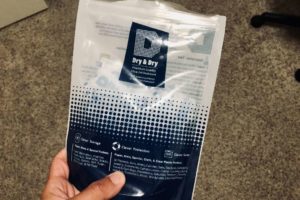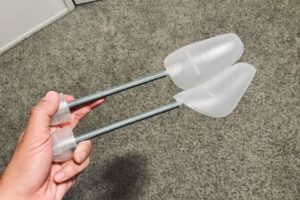The larger the sneaker collection, the more storage becomes an issue. In this article I explain how I personally store over 200 sneakers
How To Store Sneakers
The easiest way to store sneakers is in a cool, dry place in the box they came in. Other storage solutions such as drop-front boxes also exist. Storage racks help add some organization to a collection, as opposed to piles of sneaker boxes.
There are many schools of thought on the proper way to store sneakers. I have a way I like to do it, and I will cover that here. Keep in mind, other sneakerheads might tell you something different, and some of this comes down to location and preference.
You Can Store Sneakers In Their Original Box
Storing sneakers in their original box is the simplest storage method. This works well in most cases. However, cardboard shoeboxes can potentially cause dehydration and oxidization issues if the shoes are kept unworn for long periods of time.

so that the shoes don’t directly touch in the box
If you actually wear your shoes, storing them in the shoebox should be no problem. Regularly rotating through your pairs should provide enough exposure outside of the box to prevent some of the issues of long term storage.
One practice I am in the habit of doing is arranging the included paper so that the sneakers do not touch each other. I find this keeps dyes from transferring in weird ways in between the sneakers.
If the shoes are stored in a shoebox long-term and rarely taken out or worn, issues can arise. The cardboard and included paper may dry out needed moisture in the shoe and accelerate oxidization of the sneakers. Some account for this by using drop front boxes instead. These are the clear plastic boxes you see some sneakerheads rocking with. An additional benefit of these is that they are consistent in size and thus stack a little better.
You can shop for drop front boxes on Amazon here.
Regardless whether you keep them in their original box or in a drop-front, it is good practice to clean your sneakers before storing them. Shoving a grimy shoe into a box just traps all the bacteria and dirt from the outside world in a container with the shoe.
While some advise using protectant sprays on sneakers to keep them clean, I personally never bother with them. I find the sprays change the color and texture of the materials on the sneaker and for me, this negative does not outweigh the potential benefits.
Shrink Wrapping Sneakers
Shrink wrapping sneakers or storing them unworn in plastic bags can keep them clean and dirt-free in the short term. However, sneakers need access to slight humidity to keep from drying out and crumbling and benefit from being worn, even if only briefly.
How To Preserve A Pair Of Sneakers
Age, use, humidity and temperature when stored are all factors in a sneaker’s longevity. Storing sneakers in a cool, dry place while occasionally wearing and cleaning them will give them a good chance of long-term survival.

mold is an issue for your sneakers. Don’t overdo it!
Buy silica packets on Amazon
I wish it were easy to keep sneakers DS (deadstock/unworn) and clean looking forever. However, shoes were meant to be worn, and never wearing them can lead to issues like glues drying out, mold and other problems. Here are a few tips I have on preserving sneakers:
- Wear the sneakers occasionally, even if only briefly. This helps prevent the midsoles and glues from drying out completely.
- Clean the sneakers after wearing, removing any major grime from the upper and outsole. This is so you don’t trap a funky pair of kicks in the box.
- Let the shoe air out after cleaning, do not store the shoes when still damp.
- Store the sneaker in its original box or a drop front box. This way, you can stack multiple pairs and for the most part keep the elements away from the sneaker.
- If you tend to have mild dampness or mold issues, use silica packets in the box (1-2 max) and around where the sneakers are stored. You can shop for silica packets on Amazon here. Do not overdo it with the silica packets. Occasionally check the shoes to make sure they are not overdrying (if you’re wearing them at least semi-regularly it shouldn’t be that big of an issue). I’ve personally found mold to be a bigger issue with suede sneakers.
- A dehumidifier can also help if you have heavy dampness issues. Temperature and humidity control is key to avoiding both mold and dehydration
- Keep the paper stuffing that normally comes with the sneaker and use that to help the sneaker retain it’s shape when stored in the box.
Storing Sneakers With Shoe Trees
Shoe trees that stretch the sneaker can alter the shape over time. Use the paper stuffing that came with the sneaker instead, and use shoe trees only temporarily as needed for shape or to air out the sneaker.

to encourage a nice shape and/or air them out after
wearing. I never store a sneaker in the box with them
Shop shoe trees on Amazon
Lets face it, some sneakers could use a reshape! Those brick-toed Air Max 1s might look a little better if the slope on the toebox was a little pointier. That said, using shoe trees excessively can damage a sneaker, warping it’s shape and possibly causing separation from the midsole in the long term.
Sometimes I’ll use a shoe tree on a new pair of runners overnight or for a couple of nights to encourage a faster break-in and better shape. I keep a couple pairs of the IKEA shoe trees for this purpose (Amazon link here). However, I also keep the paper stuffing the shoes came with. Once they go back in the box, I take the shoe trees out and use the included stuffing to hold the sneaker’s shape moving forward.
You can shop for shoe trees on Amazon here.
Another good use for shoe trees is to air out sneakers after you are done wearing them for the day. You can build up bacteria and sweat inside the shoe. My typical routine when finished wearing a pair of kicks for a time is to clean the bottoms and then let the shoes air dry with the shoe trees in them for a few hours. Once everything seems nice and dry including the interior, I take out the shoe trees, put the paper stuffing in and back in the box they go.
How To Store A Large Shoe Collection
There are many solutions out there for shoe storage. For those with a large amount of shoes, a solid set of sturdy racks is a great way to hold and display a collection.

to hold my collection.
Shop these and similar racks on Amazon
There’s nothing that looks less organized than piles of shoeboxes all over the place. I also have a personal preference against storing sneaker boxes directly on the ground. My solution is to attain a large rack that can hold several pairs.
Here’s a link to a very similar one to what I use on Amazon. Or you can use this link to shop all the available options for racks.
When buying a rack, keep in mind how many sneakers you need to store, as these come in a few different sizes. I prefer two of the larger ones that top out at 6 ft tall for my collection. Both racks I have can hold around 80-100 pairs each.
Definitely get something sturdy as stacking dozens of sneakers in-box can get heavy. I prefer metal racks for this reason. Many of these types of storage racks go together easily using clips and friction to keep the shelves in place. The ones I have come with 5 shelves, however I usually only use 3 including one on the bottom to keep the boxes off the floor. I toss a handful of silicone packets underneath this bottom shelf just in case!
Other solutions exist, however for me these racks are easily available, relatively inexpensive, easy to put together and strong enough to hold multiple pairs.
Everyone Has An Opinion On Storing Kicks
What I put in this article is based on my experience and how I like to do things. However, not everybody is going to agree or use the same tactics. It is best to take your own local climate into account when trying to keep your collection looking and functioning at its best. What might work for me might not work exactly the same for you, so keep that in mind and adapt your storage methods as your collection grows.
